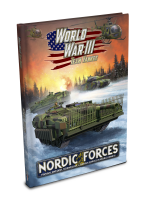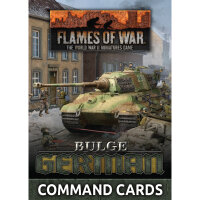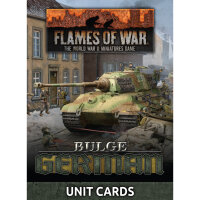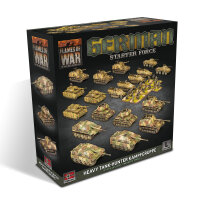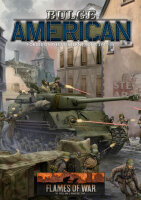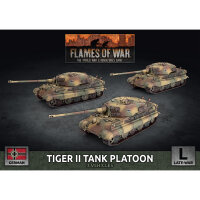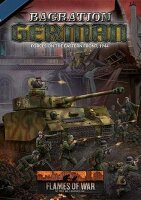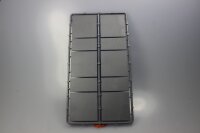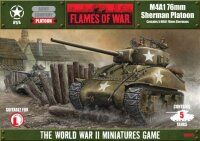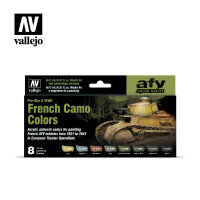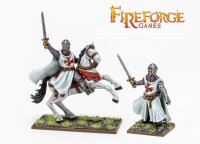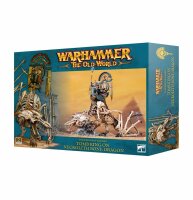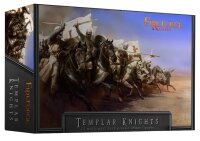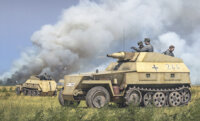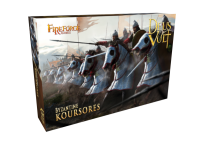Bulge: German – Forces on the Western front, 1944-45
(FW271)
Covers German forces in the west from the end of the battle for France in August 1944 into February 1945. Its background and history covers the Lorraine fighting in September 1944, the German defence during the Allied Market Garden offensive in the Netherlands, as well the German Ardennes Offensive that became known as the Battle of the Bulge, and Germany’s last major offensive in the west, Operation Nordwind in Alsace-Lorraine in early January 1945.
Background on German Army and Waffen-SS forces on the Western Front from September 1944 to February 1945.
Instructions on how to build a:
Panther (late) Brigade Tank Company,
Panzer IV Brigade Tank Company,
Brigade Armoured Assault Company,
Brigade Armoured Panzergrenadier Company,
Brigade Panzergrenadier Company,
Tiger II SS Tank Company,
Panther (late) SS Tank Company,
Armoured SS Panzergrenadier Company,
Tiger II Tank Company,
Panther (late) Tank Company,
Armoured Panzergrenadier Company,
Volksgrenadier Company,
Jagdpanther Tank-hunter Company, and
Jagdtiger Tank-hunter Company.
A Painting and Basing guide.
Peiper’s Charge Scenario.
Panzer Brigade Formations
This period sees the introduction of a variety of innovations to the German forces as they try new ideas to turn back the Allied tide. One of these was the new Panzer Brigades, designed for fighting on the Eastern Front where panzer divisions’ armoured battle groups had proved successful in cutting off and destroying Soviet spearheads. These new purpose-built battle groups were the Panzer Brigades. Organised with a panzer battalion (Brigade Panther (late) Tank Company, Brigade Panzer IV Tank Company) and an armoured panzergrenadier battalion (Brigade Armoured Assault Company, Brigade Armoured Panzergrenadier Company, Brigade Panzergreandier Company) equipped with the latest equipment like the Panzer IV/70 tank-hunter, the new Panther (late) (Panther ausf G, with Front armour 10), as well as tried and tested Panzer IV tanks and StuG assault guns.
The Panzer Brigade’s infantry component could be either the Brigade Armoured Assault Company with troops armed with the StG44 assault rifle (Range 8”/20cm, Halted and Moving ROF 3) mounted in Sd Kfz 251 armoured half-tracks. This hard-hitting infantry is backed up with plenty of firepower from their half-track FlaK Platoons, armed either Sd Kfz 251 (2cm) or Sd Kfz 251 (Triple 15mm) half-tracks. The company can also call on half-track mounted 8cm mortars, 7.5cm guns, and Flame-throwers, as well as a 12cm Mortar Platoon. The formation can also include Panzer IV/70 tank-hunters.
The Brigade Armoured Panzergrenadier Company has a similar organisation, but instead of the infantry being armed with StG44 assault rifles this infantry is more conventionally armed with MG42 teams, giving them longer range, but with almost as good firepower.
Some of the Panzer Brigades were not mounted in Sd Kfz 251 half-tracks, but in trucks. These are represented by the Brigade Panzergrenadier Company. Much like the armoured equivalent above, they are equipped with MG42 teams with Panzerfaust, have the ground mounted machine-guns, 8cm mortars, 5cm and 7.5cm anti-tank guns, and 2cm AA guns.
All of the troops of the Panzer Brigade, being hastily formed, are Motivation Reluctant 5+, but with Third Reich Last Stand 4+, Skill Trained 4+, and Is Hit On Aggressive 3+. Though they have lesser rating than the Waffen-SS or other Panzer troops, they allow you to get an excellent selection and number of troops and weapons into your chosen points value.
Both these types of infantry are armed with Panzerfausts for anti-tank defence, but now in much larger numbers. These teams Panzerfausts are Limited 2, meaning they can use up to two of their Units teams as Panzerfaust weapon in Shooting and in Assaults.
Waffen-SS Formations
Bulge: German also adds more to the Waffen-SS troops available already in D-Day: Waffen-SS, adding three more Formations. The first of these formations is the Tiger II SS Tank Company. The Tiger II (8.8cm) heavy tanks of 501th SS Heavy Tank Battalion (Schwere SS-Panzer Abteilung 501). This formation can be field purely as Tiger II heavy tanks, or a mix of Tiger IIs, Tiger Is or Panthers, and infantry, creating a mixed Kampfgruppe (battle group).
The Tiger II is a massive beast. It has Front armour 16 and is armed with the long 8.8cm gun (Range 48”/120cm, ROF 2/1, AT 17 and FP 3+).
Out second SS formation is the Panther (late) SS Tank Company, giving them the new Panther (late) with its Front armour 10. The new Panther retains all the other features of the Panther from D-Day: German and Bagration: German. This formation can also be fielded as solely Panther (late) tanks or a mix of Panther (late), Tiger II and infantry.
Both these armoured formations can also field their own anti-aircraft tanks, taking either Wirbelwind (Quad 2cm) or Ostwind (3.7cm).
The last SS formations is the Ardennes Armoured SS Panzergrenadier Company, which is a Sd Kfz 251 infantry formation. The panzergrenadier teams are MG42 teams with Panzerfasut, but now have Limited 2 on their Panzerfaust weapons, so two team per Unit can be use it in Shooting and Assaults. The formation can also include armour in one of its compulsory black boxes from either Tiger II, Panther (Late), Panzer IV or Panzer IV/70. The Formation can include anti-aircraft tanks, machine-guns, armoured 8cm mortars, 7.5cm anti-tank guns or armoured flame-throwers.
Like in D-Day: Waffen-SS, these troops are well-motivated, but require skilled input from their commander (Fearless, Trained, Aggressive). The Old Hand rule gives units within range of their commander Tactics 3+ on Skill based Movement Orders.
Heer (Army) Panzer Divisions Formations
These Formations represent the armoured power of the German Heer (Army) concentrated in the west for the Ardennes Offensive. Topped up with the latest equipment if available, none of these divisions would be as powerful again for the rest of the war. Panzer IV, Panther (late), StuG, Panzer IV/70, and Jagdpanthers all fought to make the Ardennes Offensive a success. These formations are all well supported with infantry, artillery, armoured cars, anti-tank, and anti-aircraft.
The first Formation is the Tiger II Tank Company, like the SS already mentions, the Army Heavy Tank Battalion began to also field the Tiger II heavy tank. This heavily armoured (Front 16, Side 8, Top2) and armed (long 8.8cm gun, AT 17), the Tiger II is a formidable foe for any Allied force. As well as the Tiger II heavy tanks, you can also take one Unit as Tiger I tanks and Wirbelwind or Ostwind AA tanks.
The second formation in this section introduces the Panther (late) tank for the experienced Panzer troops. The Panther (late) Tank Company can take two or three Panther (late) Tank Platoons, with the third Unit having options for infantry as well. The fourth Formation Unit is a Wirbelwind or Ostwind AA Tank Platoon.
The Ardennes Armoured Panzergrenadier Company lets you take Sd Kfz 251 (MG) half-tracks with one half-track replaced with the new Sd Kfz 251 (2cm) to give your panzergrenadier transports a bit more firepower with its ROF 3/2, anti-tank 5, and Firepower 5+. The platoon itself is equipped with MG42 teams with Panzerfaust anti-tank weapons with the new Limited 2 special rule. The formation’s third infantry option can be a third Ardennes Armoured Panzergrenadier Platoon, or a Panther (late), Panzer IV/70, or Panzer IV tank unit. The Formation can also have machine-guns, armoured 8cm mortars, armoured 7.5cm gun, Grille (late) 15cm gun, armoured flame-thrower, 7.5cm tank-hunter and light AA platoons.
The panzer troops are well-disciplined and trained (Confident, Veteran, Careful).
Volksgrenadiers
Another important element in the German forces after Normandy was the Volksgrenadier (People’s Grenadier) Divisions. These were the rebuilt infantry divisions from Normandy and the Eastern Front, given a new name and a new organisation. A Volksgrenadier Company has three combat units and the usual selection weapons support you would expect from a German infantry company, machine-guns, 8cm and 12cm mortars, 7.5cm tank-hunters, and Scout. They also have up to two 7.5cm Gun Platoons, which along with the mortars, provides them with substantial artillery assets.
However, the combat units are divided into two Volksgrenadier Assault Platoons and a Volksgrenadier Rifle Platoon. The Assault Platoons are equipped with StG44 assault rifle teams. Like SMGs these weapons have a ROF 3/3, but with an extended range of 8”/20cm. On top of this they have MG42 and Panzerfaust, both with Limited 2. This means that two teams per Shooting or Assault phase can use MG42, giving them extended shooting range (16”/40cm) to provide fire support to rest of the Unit. Another two teams each turn can fight as Panzerfausts, great for anti-tank defence and offence.
The third unit is conventionally armed with MG42 & K98 rifle team with Panzerfaust, offering further longer-range fire. Because they are refreshed with mostly raw recruits with only limited training times the Volksgrenadier Company is rated Motivation Reluctant 5+, but with Third Reich Last Stand 4+. Their Skill is Trained 4+ and they are Aggressive Hit On 3+.
Heavy Tank-hunters
Bulge: German contains two heavy tank-hunter Formations. The first of these is the Jagdpanther Tank-hunter Company that is primarily armed with the Jagdpanther tank-hunter. Like the Panther is has good front armour (Front 9, Side 5, Top 1), but is armed with the same long 8.8cm gun as the Tiger II with its long 48”/120cm range and anti-tank 17.
This formation can also field Hornisse, Panzer IV/70 tank-hunters or StuG assault guns. The Hornisse is worth a special mention as it is now a new plastic kit along with the Hummel (see more below). The Hornisse is armed with the same formidable gun as the Jagdpanther, but is a more tradition tank-hunter formation in a open top fighting compartment is just Front armour 2.
The second formation is the mighty Jagdtiger. This is on the same hull as the Tiger II, but with more armour and a bigger gun. The Jagdtiger is virtually invulnerable from the front with Front armour 17. It gun is a 12.8cm gun, with rounds so big it them come in two parts and require two loaders. The guns has a long range of 48”/120cm, Rate of fire 2/1, Anti-tank 18 and Firepower 2+. It is also had Brutal, making Infantry and Gun teams reroll their saves. It is Slow Firing, giving its moving ROF +1 to the score required to hit.
Like the Jagdpanthers, this Formation can also take other armoured units, in this case Panzer IV or StuG Tank Platoon.
Both the Jagdpanther and Jagdtiger formations can also have a Wirbelwind or Ostwind AA Tank Platoon.
These specialist troops are well-disciplined and trained (Confident, Veteran, Careful).
Support
The support section in divided into three parts, SS, Volks and Heer. The SS Support Units include a Sd Kfz 250 SS Scout Troop, a Sd Kfz 234 SS Scout Troop which can be either the Sd Kfz 234 (2cm) (Sd Kfz 234/1) or the Puma (5cm) (Sd Kfz 234/2).
The Grille (Late) SS Gun Platoon is a little unusual, as these vehicles are usually fielded in pairs. However, during the Ardennes Offensive the 1st SS group theirs together in a battery of six to concentrate their firepower.
The Volksgrenadier Divisions and the Volks corps troops provided all branches of the German armed forces with support. You can take Volks Hetzer Tank-hunter Platoons, Volks StuG Tank-hunter Platoon and Volks 10.5cm Artillery Battery, all the same ratings as the Volksgrenadiers. Due to shortage of artillery specialist to command the batteries, Volks 10.5cm Artillery Batteries have six guns instead of four, but there are less batteries in regiment.
The Heer Support Units make up the bulk of the available support. There are armour cars, self-propelled and gun tank-hunters, 10.5cm and 15cm artillery, rocket launchers, observers, anti-aircraft and aircraft. A few key units to take note of are the Hetzer Flammpanzer Platoon, Sturmtiger Assault Howitzer Platoon, Hummel Artillery Battery, and ME 262 Fighter-Bomber Flight.
If you have out Hetzer model already you may have noticed the parts to the Hetzer Flammpanzer it comes with. Now you can field it in the Hetzer Flammpanzer Platoon. The Hetzer Flammpanzer is equipped with Flame-thrower with a Range 4”/10cm, ROF 4/4, AT 2, FP AUTO. The Flame-thrower rule means hit Infantry Gun and Unarmoured Tank teams reroll successful Saves and are automatically Pinned Down. Armoured Tank team must make their Save against their Top Armour.
Another weapon design specifically for use against building and fortifications is the Sturmtiger, a rocket howitzer mounted on the hull of a Tiger I with even more armour than it (Front 15). It is armed with a 38cm rocket that is fired as artillery with range 56”/140cm, AT 4, FP 2+. It is Brutal and has the Bunker Killer and Rocket Howitzer rules. Bunker Killer allows it to target Nest and Bunker teams despite being an Artillery Bombardment. Rocket Howitzer allows it to fire its Bombardments without the normal penalty for have only 1 or 2 weapons firing and gives it one ranging in attempt for each weapon in the bombardment.
As mentioned earlier the Hummel is getting a new plastic model. The Hummel Artillery Battery provides some hard-hitting fire power. Its artillery bombardment has Range 80”/200cm, AT 3 FP 2+, while its direct fire is Range 16”/40cm, ROF 1/-, AT 11 FP AUTO and Brutal.
The Me 262 Sturmvogel (Storm Bird) was used during the German campaigns for late 1944 and early 1945 for ground attack. It was felt its size and speed would allow it to get through where larger German bombers could not. As a fast moving Jet it is Hit On 6. It is armed with two 30mm cannons (Range 6”/15cm, ROF -/2, AT 6, FP 5+) and a pair of 500 kg bombs (Range 6”/15cm, ARTILERY, AT 4, FP 2+, Bombs).
New Plastic Models
The book coincides with the release of the following plastic models:
Panther (late)
Jagdpanther
Sd Kfz 251 (2cm)
Sd Kfz 251 (Triple 15mm)
Tiger II
Jagdtiger
Hornisse
Hummel
Hetzer Flammpanzer
Peiper's Charge
The book also includes the Peiper’s Charge Scenario. This scenario pits Kampfgruppe Peiper against the defending American as they try and stop 1. SS-Panzerdivison and their push across the Ardennes. The game can be played as three separate parts, playing each of the three table setups one after the other. Or you can play it with you gaming friend is one big game over three tables.
Battlefront Miniatures
